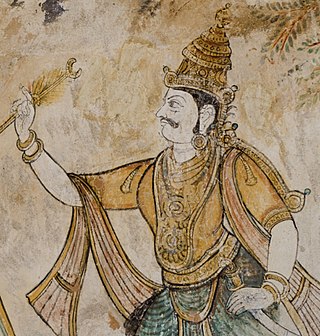
Rajaraja I, also known as Raja Raja the Great, was a Chola emperor who reigned from 985 CE to 1014 CE. He is known for his conquests of Southern India and parts of Sri Lanka, and increasing Chola influence across the Indian Ocean.

Rajendra I, often referred to as Rajendra the Great, Gangaikonda Cholan, and Kadaram Kondan, was a Chola Emperor who reigned from 1014 and 1044 CE. He was born in Thanjavur to Rajaraja I and his queen Vanathi and assumed royal power as co-regent with his father in 1012 until his father died in 1014, when Rajendra ascended to the Chola throne. During his reign, the Chola Empire reached its zenith in the Indian subcontinent; it extended its reach via trade and conquest across the Indian Ocean, making Rajendra one of only a few Indian monarchs who conquered territory beyond South Asia.

Chola Nadu is a cultural region of the Tamil Nadu state in southern India. It encompasses the lower reaches of the Kaveri River and its delta, and formed the cultural homeland and political base of the Chola Dynasty which ruled large parts of South India and parts of Sri Lanka between the 9th and 13th centuries CE. Uraiyur served as the early Chola capital, then medieval Cholas shifted to Thanjavur and later cholas king Rajendra Chola I moved the capital to Gangaikonda Cholapuram in Ariyalur in the 11th century CE.
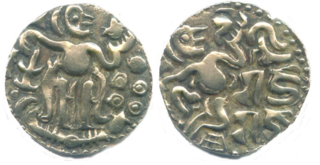
Rajadhiraja I was a Chola emperor, as the successor of his father, Rajendra I. He was the only Chola emperor who was killed while leading his army in war, and although he had a short reign, he helped his father conquer several territories as well as to maintain the Chola authority over most of Sri Lanka, Eastern Chalukya and Kalinga, among others. He also established imperial relations with overseas allies despite a series of revolts in the territory.
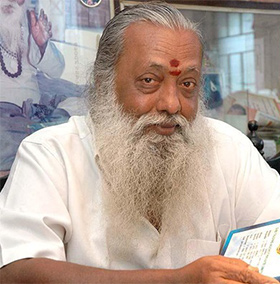
Balakumaran was an Indian Tamil writer and author of over 200 novels, 100 short stories, and dialogue/screenplay writer for 23 films. He also contributed to Tamil periodicals such as Kalki, Ananda Vikatan and Kumudam. His notable works as a dialogue writer in Tamil Cinema include Nayakan, Guna, Baashha and Pudhupettai.

The Chola dynasty was a Tamil dynasty originating from southern India. At its height, it ruled over an expansive maritime empire known as the Chola empire. The earliest datable references to the Chola are from inscriptions dated to the 3rd century BCE during the reign of Ashoka of the Maurya empire. The Chola empire was at its peak and achieved imperialism under the Medieval Cholas in the mid-9th century CE. As one of the Three Crowned Kings of Tamilakam, along with the Chera and Pandya, the dynasty continued to govern over varying territories until the 13th century CE.
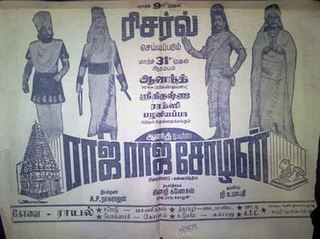
Rajaraja Cholan is a 1973 Indian Tamil-language biographical film directed by A. P. Nagarajan and written by Aru Ramanathan. Based on Ramanathan's play of the same name about the life of the Chola king Rajaraja I, the film stars Sivaji Ganesan in the title role and was the first Tamil CinemaScope film. It was released on 31 March 1973, and ran for over 100 days in theatres.

Kulothunga II was a Chola Emperor from 1133 CE to 1150 CE. He succeeded Vikrama Chola to the throne in 1135 CE. Vikrama Chola made Kulothunga his heir apparent and coregent in 1133 CE, so the inscriptions of Kulothunga II count his reign from 1133 CE. According to historians Nilakanta Sastri and T.N Subramanian, Kulottunga Chola II was not the son of Vikrama Chola and they have suggested that there was a break in the line of succession.
Sholavandan is a panchayat town in Madurai district in the Indian state of Tamil Nadu. It is located on the left bank of the Vaigai River, sixteen miles north west of Madurai. It is one of 12 "town- panchayats" of Madurai district.
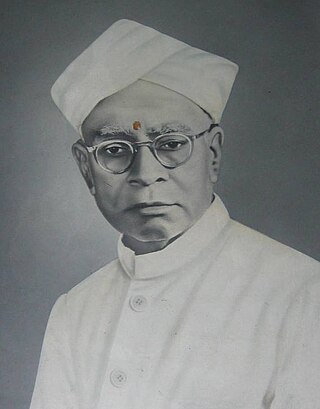
Kallidaikurichi Aiyah Nilakanta Sastri was an Indian historian who wrote on South Indian history. Many of his books form the standard reference works on the subject. Sastri was acclaimed for his scholarship and mastery of sources and was a recipient of the third highest Indian civilian honour, the Padma Bhushan.
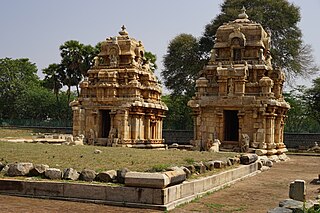
Irunkōvēl, also known as Irungkōvēl, Irukkuvēl, and Ilangōvēlir, was a title of the Irunkōvēl line of Velir kings. The Irunkovel line of kings ruled over Konadu identified with the Kodumbalur and surrounding areas in ancient Tamilakkam. They trace their lineage to the clan of Krishna; one of the inscriptions at Kodumbalur belonging to one of the kings in the Irunkovel line, namely Tennavan Irunkōvēl alias Maravan Bhutiyar, declares that he belonged to the kshatriya dynasty which is descended from Yadu. The Moovar Koil record of Irukkuvel chief Boothi Vikramakesari lauds his father, Samarabirama, as Yadu-vamsa-ketu.
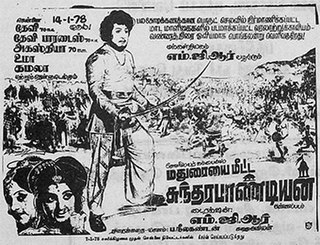
Madhuraiyai Meetta Sundharapandiyan is a 1978 Indian Tamil-language historical action film, directed by M. G. Ramachandran, starring himself, M. N. Nambiar, P. S. Veerappa, Latha and Padmapriya. It was Ramachandran's final film as an actor. The film is based on the serial novel Kayalvizhi by Akilan. It was released on 14 January 1978 and became a box-office bomb, but Latha won the Tamil Nadu State Film Award for Best Actress.

Paavai Vilakku is a 1960 Indian Tamil-language drama film directed by K. Somu and written by A. P. Nagarajan. The film stars Sivaji Ganesan, Sowcar Janaki, Pandari Bai, M. N. Rajam and Kumari Kamala. It is based on Akilan's novel of the same name, serialised in the Tamil magazine Kalki. Paavai Vilakku was released on 19 October 1960, Diwali day.

Pinnangudi is a tiny village in Illuppur taluk of Pudukkottai district of Tamil Nadu in India.
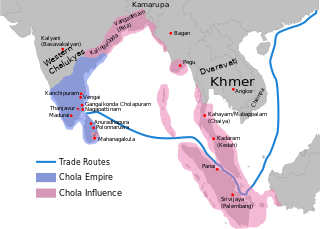
Tamils maintained a good relationship with the Chinese, with evidence of trade relations going back to 2nd century BC.

The Cholas, the Tamil kings of the Chola dynasty who had ruled most parts of South India, maintained a strong relationship with the Chinese.
Kaiperambalur is a panchayat village of the Kizhamathdur district in Perambalur, Tamil Nadu, India. It was formally part of the Tiruchirappalli district.
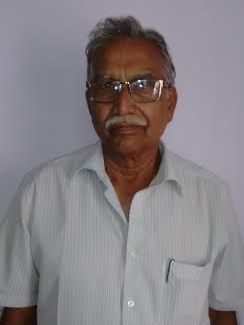
Kudavayil Balasubramanian is an archaeologist from Tamil Nadu, India. He is former curator and publication manager at Saraswathi Mahal Library located at Thanjavur. He is credited with discovering more than 100 inscriptions, coins, copper plates, sculptures, and paintings now in museums and temples in that state.
Vamsottharakar Temple is a Hindu temple dedicated to the deity Shiva, located at Perungalur in Pudukkottai taluk of Pudukkottai district in Tamil Nadu, India.
Rajarajeswaramudaiya Mahadevar Temple is a Shiva temple located in Sivapuram hamlet in Tiruvallur district of Tamil Nadu, India.














